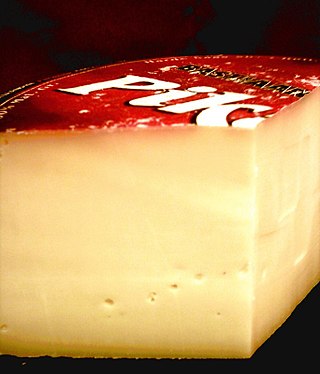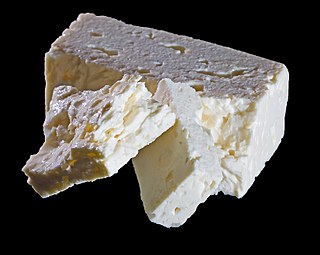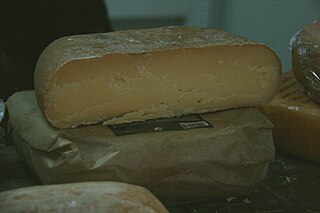See also
- List of cheeses – List of cheeses by place of origin
| Bondost | |
|---|---|
| Country of origin | Sweden |
| Source of milk | Cows |
| Texture | Firm |
| Aging time | 6–8 weeks |
Bondost (sometimes spelled bond-ost, Swedish for "farmer cheese") is a Swedish cheese, also made in the United States, chiefly in New York. [1] [2]
This cow's-milk cheese is cylindrical in shape, about 13 cm (5.1 in) across and 9 cm (3.5 in) high. After the milk (either raw or pasteurized) is curdled, heated, cut, salted, stirred, pressed into forms, and immersed into brine for a day or two, the new cheese is ripened for six to eight weeks. Sometimes bondost is spiced with cumin or caraway seeds, which are incorporated into the curd just before it is molded.
It has a firm texture providing a mild tasting cheese that can be served as an appetizer or for snacking. When produced, it is brine cured, allowed to dry, and ready to serve in approximately 2 months. Several varieties are cured for 1 to 2 days, while the most flavorful varieties are cured for several weeks.

Mozzarella is a southern Italian semi-soft, non-aged cheese traditionally made from Italian buffalo's milk by the pasta filata method.

Gouda cheese is a sweet, creamy, yellow cow's milk cheese originating from the Netherlands. It is one of the most popular cheeses worldwide. The name is used today as a general term for numerous similar cheeses produced in the traditional Dutch manner.

Brie is a soft cow's-milk cheese named after Brie, the French region from which it originated. It is pale in color with a slight grayish tinge under a rind of white mould. The rind is typically eaten, with its flavor depending largely upon the ingredients used and its manufacturing environment. It is similar to Camembert, which is native to a different region of France. Brie typically contains between 60% and 75% butterfat, slightly higher than Camembert.

Halloumi or haloumi is a cheese of Eastern Mediterranean origin made from a mixture of goat's and sheep's milk, and sometimes also cow's milk. Its texture is described as squeaky. It has a high melting point and so can easily be fried or grilled, a property that makes it a popular meat substitute. Rennet is used to curdle the milk in halloumi production, although no acid-producing bacteria are used in its preparation.

Feta is a Greek brined white cheese made from sheep's milk or from a mixture of sheep and goat's milk. It is soft, with small or no holes, a compact touch, few cuts, and no skin. Crumbly with a slightly grainy texture, it is formed into large blocks and aged in brine. Its flavor is tangy and salty, ranging from mild to sharp. Feta is used as a table cheese, in salads such as Greek salad, and in pastries, notably the phyllo-based Greek dishes spanakopita "spinach pie" and tyropita "cheese pie". It is often served with olive oil or olives, and sprinkled with aromatic herbs such as oregano. It can also be served cooked, as part of a sandwich, in omelettes, and many other dishes.

Goat cheese, goat's cheese, or chèvre is cheese made from goat's milk. Goats were among the first animals to be domesticated for producing food. Goat cheese is made around the world with a variety of recipes, giving many different styles of cheeses, from fresh and soft to aged and hard.

Camembert is a moist, soft, creamy, surface-ripened cow's milk cheese. It was first made in the late 18th century in Camembert, Normandy, in northwest France. It is sometimes compared in look and taste to brie cheese, albeit with a slightly lower butterfat content than brie's typical 60% and 75% by weight.

Bulgarian cuisine is part of the cuisine of Southeast Europe, sharing characteristics with other Balkan cuisines. Bulgarian cooking traditions are diverse because of geographical factors such as climatic conditions suitable for a variety of vegetables, herbs, and fruit. Aside from the vast variety of local Bulgarian dishes, Bulgarian cuisine shares a number of dishes with Persian, Turkish, and Greek cuisine.
Norwegian cuisine in its traditional form is based largely on the raw materials readily available in Norway and its mountains, wilderness, and coast. It differs in many respects from continental cuisine through the stronger focus on game and fish. Many of the traditional dishes are the result of using conserved materials, necessary because of the long winters.

Saint-Nectaire is a French cheese made in the Auvergne region of central France.

Prästost is a Swedish cheese with historical roots in Sweden's one-time custom of paying tithes with agricultural goods including milk. Milk spoils easily so most farms instead produced a small eyed cheese that had its curing process started by mixing in a small batch of fermented curds. This was common practice from the 16th though 19th centuries. Today, this style of cheese once produced in churches across Sweden is factory-made from pasteurized cow's milk.

There are many different types of cheese. Cheeses can be grouped or classified according to criteria such as length of fermentation, texture, methods of production, fat content, animal milk, and country or region of origin. The method most commonly and traditionally used is based on moisture content, which is then further narrowed down by fat content and curing or ripening methods. The criteria may either be used singly or in combination, with no single method being universally used.

Mallorca cheese is a Spanish cheese made exclusively on the island of Mallorca, one of the Balearic Islands in the Mediterranean Sea. It has Protected Designation of Origin and is made from the pasteurized milk of cows, goats and/or sheep which live on the island. The cheeses are slightly tapering, flat cylinders which measure 12–20 cm (5-8 inches) across and 7-9 cm (3-4 inches) high. They weigh from 750 g to 4 kg (1.5-9 lbs). Mallorca cheese is produced in three types:
Murcian cheese is a fatty goats' milk cheese from the Murcia region of south-east Spain. It has a Protected Designation of Origin. The cheese is made exclusively using goat's milk of the Murcian breed from registered herds which graze freely on scrub and coarse pasture characteristic of that dry geographical zone. The cheese is made in two forms:

Surströmming is lightly salted fermented Baltic Sea herring traditional to Swedish cuisine since at least the 16th century. Surströmming or fermented herring is distinct from fried or pickled herring.

Tulum cheese is a traditional Turkish goat's milk cheese ripened in a goatskin casing, called tulum in Turkish.
Lighvan is a sour, hole filled brined curd cheese traditionally made from sheep's milk in Liqvan, a village in East Azerbaijan, Iran.

Stracciata is a fresh pasta filata cheese produced in Italy. Stracciata is formed into flat strips of about 4–5 cm wide, 1 cm thick and folded in on itself in a uniform manner or woven wire, made with cow's milk. The name stracciata means "tattered" in Italian.